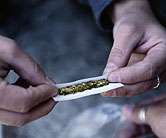Medical marijuana: Voodoo or legitimate therapeutic choice?

(HealthDay)—Imagine a 68-year-old woman with advanced breast cancer, looking for a better way to ease her chronic pain, low appetite, fatigue and nausea. Should she or shouldn't she be prescribed marijuana?
That's the question physicians debate in the "Clinical Decisions" section of the New England Journal of Medicine released online Feb. 20.
According to the hypothetical case study in the journal, a woman named Marilyn has metastatic breast cancer that has spread to her lungs and spine. She's taking chemotherapy and two anti-nausea drugs that just aren't working. Despite taking 1,000 milligrams (mg) of acetaminophen, such as Tylenol, every eight hours, she's in pain. At night, she sometimes takes 5 to 10 mg of oxycodone, a narcotic pain reliever similar to morphine, to help relieve the pain so she can sleep.
Marilyn lives in a state where marijuana is legal for personal medicinal use, and her family stands ready to grow it for her.
Why not let Marilyn try it?
One reason not to, in the view of one of the "con" argument's authors, Dr. Robert DuPont, is that it probably wouldn't help her. "Although marijuana probably involves little risk in this context, it is also unlikely to provide much benefit," said DuPont, a clinical professor of psychiatry at Georgetown Medical School in Washington, D.C., and the first director of the National Institute on Drug Abuse under Presidents Nixon, Ford and Carter.
Marijuana is a dry, shredded mix of flowers, stems, seeds and leaves of the hemp plant Cannabis sativa. People usually smoke it as a cigarette or in a pipe. It's the most commonly abused illegal drug in the United States, according to the U.S. National Library of Medicine.
In an interview, DuPont said that because smoked marijuana has not been reviewed and approved by the U.S. Food and Drug Administration for safety, effectiveness and purity, it would be inappropriate for a physician to prescribe it. "It would divert the attention away from an effective medical treatment and get her into something that's at best voodoo," he said.
The cannabis (marijuana) plant contains hundreds of pharmacologically active compounds that could interact with the medications Marilyn's now taking, DuPont said. It's impossible to know the chemical make-up or potency of a given dose, he noted, adding, "Medical marijuana has no dose. There is nothing else in medicine like that."
DuPont said it's also uncertain how Marilyn might react to the experience of smoking marijuana. He said the drug could affect her ability to think effectively. And just the act of smoking, coupled with the impact of the cancer on her lungs, could reduce her ability to get oxygen to her brain, he added.
Rather than offering Marilyn marijuana that is smoked, DuPont would prefer she be offered drugs that have been shown to be highly effective for treating nausea and vomiting caused by chemotherapy, such as dexamethasone and aprepitant. Should these not work, he said, he would opt for one of two prescription "cannabinoid" pills that are available: dronabinol (Marinol) or nabilone (Cesamet), which are both approved by the FDA for the same purpose.
DuPont argued that with the oral cannabinoids, the precise dosages have been established and the medications take effect more gradually than does smoked marijuana, and thus would be less likely to cause anxiety or panic.
Dr. J. Michael Bostwick wrote the "pro" argument for offering Marilyn marijuana. Bostwick, a professor in the department of psychiatry and psychology at the Mayo Clinic College of Medicine, in Rochester, Minn., said he told the editors at the New England Journal of Medicine that he could have made the case for either side. He had a family member with substance-abuse issues involving marijuana. "I kept hearing marijuana is harmless and doesn't cause any problems, and yet I was seeing addiction," he said.
Still, Bostwick said he would give marijuana to Marilyn.
"If it would help, why not? I say that, knowing that much of what we do in medicine is empirical, but knowing there are arguments for exploring the possibilities the whole endocannabinoid system might offer," he said. Bostwick explained that there are receptors for cannabinoids in the brain, the gastrointestinal system and immune tissues—which suggests the body may be designed to accommodate or benefit from marijuana.
"The downside of trying medical marijuana is small. If she did not have a recent experience with [marijuana], she might not even like it," he said.
Bostwick believes the federal government should make marijuana, which is now illegal in the United States, a "schedule II" drug, thereby allowing researchers to study its safety and effectiveness. Schedule II drugs are considered to have a high abuse risk but also have safe and accepted medical uses. Schedule II drugs include morphine, cocaine, oxycodone (Percodan), methylphenidate (Ritalin) and dextroamphetamine (Dexedrine).
Bostwick argues that Marilyn's situation is a clear case for the need to apply clinical judgment: "In the context of an ongoing relationship, as one more treatment in a wide pharmacopeia, it's up to the doctor," he said.
More information: To learn more about marijuana, visit the U.S. National Library of Medicine.
Health News Copyright © 2013 HealthDay. All rights reserved.














